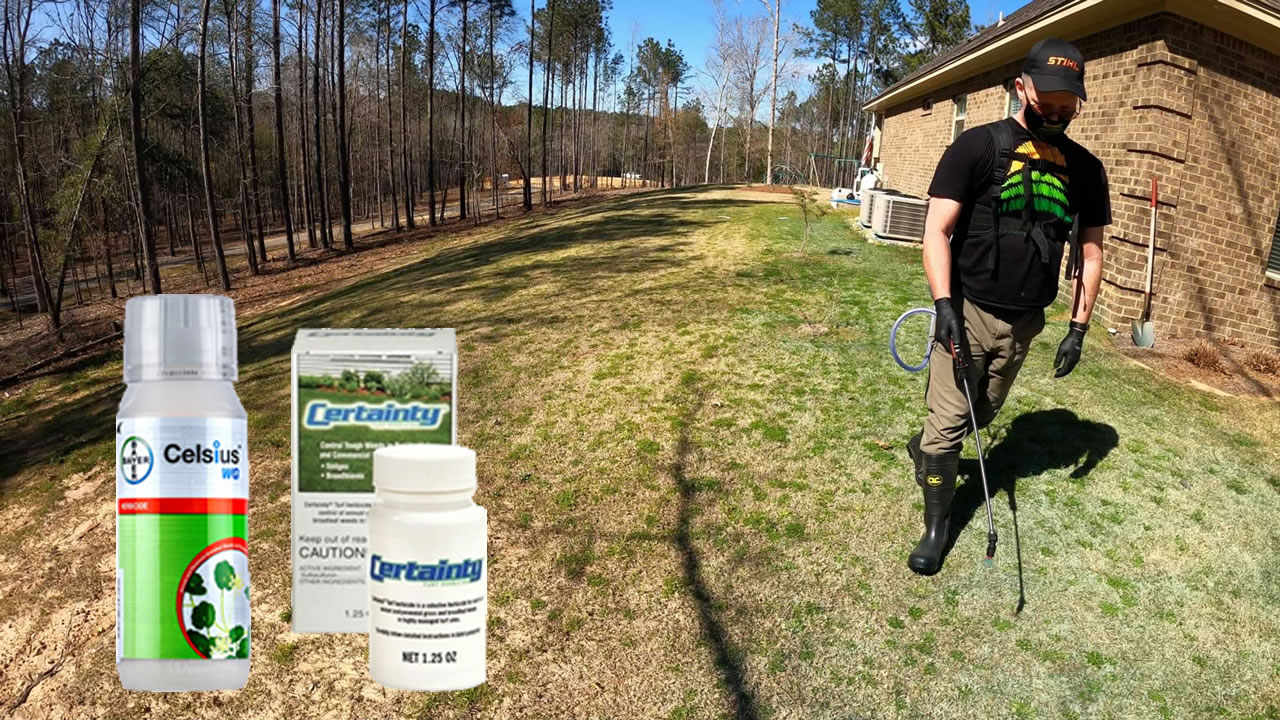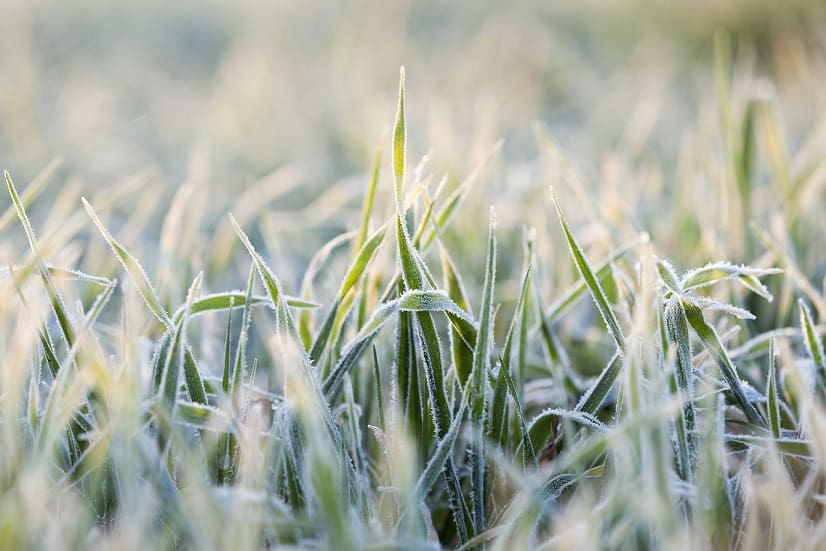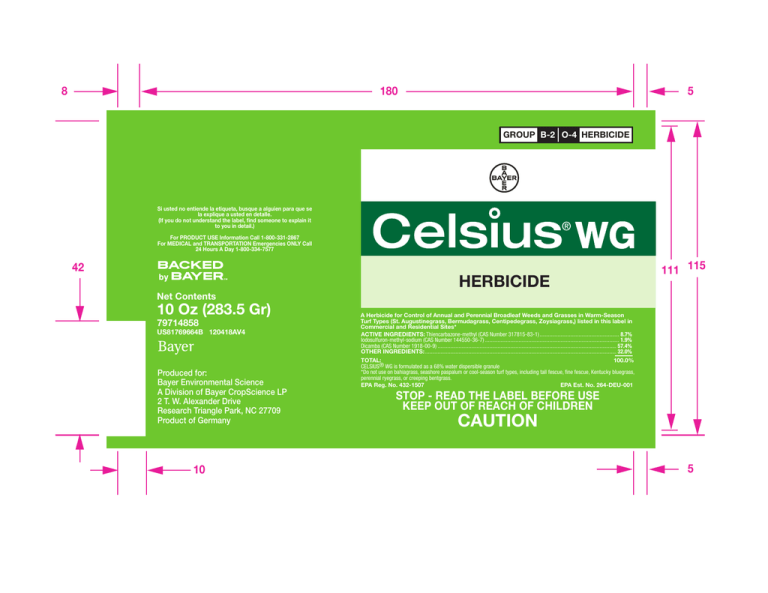45 celsius herbicide temperature
Celsius WG Herbicide Help - Questions and Answers - DoMyOwn.com As long as the temperature during the application of the Celsius is not 85 degrees or above, then it does not matter what temperature it reaches mid day. The best time to apply herbicides is either early morning when dew is still fresh on the ground or late afternoon when the lawn and weeds are under less stress from the environment. PDF Home | LabelSDS Home | LabelSDS
Certainty or Celcius Application Temperatures | Lawn Care Forum In sub-80 degree temperatures, is Certainty a more effective herbicide than Celcius? I've been disappointed in the impact I've seen with Celcius and I think it may be that temperatures were not consistently over 75-80 degrees when I applied it. UltimateLawn's DFW StAug Lawn Journal Reply Quote CenlaLowell Premium Member Joined Apr 21, 2017

Celsius herbicide temperature
Cold Temperature and Herbicide Storage - Cornell University Cold temperatures can affect herbicide performance; applications of postemergence products under cool conditions may result in delays in symptom development and some treatments may fail altogether. Cold temperatures are also a concern for stored herbicides, particularly liquid products. Freezing (which may occur at temperatures below 32 F for ... Weather Conditions and Herbicide Performances - Plant & Pest Advisory The ideal air temperature for applying most post-emergence herbicides is between 65°F and 85°F. At lower temperature, weed control will be slower, especially with systemic herbicides such as glyphosate, Poast, Select, or Sandea that are more slowly absorbed and translocated by the weeds compared to applications at higher temperatures. Temperature and Herbicide Application Questions Ideal temperatures for applying most POST herbicides are between 65 and 85 F. Weeds may be killed slowly below 60 F. Some herbicides may injure crops if applied above 85 F. Avoid applying volatile herbicides such as 2,4-D ester, MCPA ester and dicamba during hot weather, especially near susceptible broadleaf crops, shelterbelts, or farmsteads.
Celsius herbicide temperature. Celsius WG Herbicide | Post-Emergent Weed Killer | Solutions Pest & Lawn Spray Celsius WG Herbicide when turf is established or 4 weeks have passed for newly established turfgrasses. Weed control is more rapid when soil temperatures are above 65 degrees, when soil moisture is adequate for weed growth, and when weeds are not under environmental stress (e.g. drought). Safety Information Celsius WG Herbicide: The Quick Guide - farmerdb.com You can observe the effects of the selective herbicide Celsius WG in 1 to 4 weeks after application. The time period is influenced by the outside temperature and soil moisture. If these two are suitable for the growth of weeds, then the results can appear in less than 4 weeks even. Buy Celsius and Certainty Herbicide Kit | Golf Course Lawn Celsius and Certainty Herbicide Kit with Surfactant and Dye - Warm Season Grass. $349.99. $329.99. Quantity: Add to cart. In stock! Usually ships within 24 hours. Are Temperatures Too High to Safely Apply Herbicides in Turf? As temperatures exceed 90° F, cool-season grasses become stressed and consumption of carbohydrates exceeds production through photosynthesis. Thus, grasses such as tall fescue with good tolerance to herbicides during active growth may be naturally more susceptible to herbicide injury during periods of physiological stress.
Celsius WG Herbicide - Lawn Dork™ Maximum Yearly Limits Do not exceed 0.17 oz / 1,000 square feet of Celsius WG per year (365 days). Time Between Applications Do not use spray adjuvant with Celsius WG at temperatures above 90°F. Mowing Instructions Do not mow immediately after treating with Celsius WG or before spray has dried. Does ambient temperature affect herbicide performance? Short answer: Efficacy is much better at 20 degrees C than at 30 degrees C. Longer answer: Spraying glyphosate resistant barnyard grass at lower temperatures is more effective than under hotter conditions. If barnyard grass is tested for herbicide resistance during the cooler parts of the year it may appear susceptible to the field rate of ... Weedsmart: Does ambient temperature really affect herbicide performance ... Herbicides applied under the wrong conditions can appear to fail, however the reason may not be herbicide resistance. The University of Adelaide associate professor, weed management, Chris Preston, said most herbicides had a temperature range at which they were most effective in controlling target weeds. "Applying herbicides outside the optimal temperature range is likely to contribute to a ... Celsius WG Herbicide Product | Envu Environmental Science US - Bayer Celsius WG Zoom Back to products Also labelled for use in these areas: Lawn & Landscape Herbicide Celsius WG Product Overview Key Benefits Use & Control Related Resources Product Guides Special Labels Similar Products Herbicide Prograss EC Prograss EC provides both pre- and post-emergent control of... See product Herbicide Ronstar FLO
Celsius WG Herbicide - diypestcontrol Unlike other herbicides, Celsius WG can be applied when the weather is unbearably hot, even when temperatures exceed 90 degrees (reducing risk of phytotoxicity). As a post-emergent herbicide, it works very well on southern grasses such as St. Augustine, without fear of damaging turf. What to Expect from Herbicides in Cold Weather - ONvegetables There is no question that cold weather will impact post emergent herbicide performance. Optimal temperatures are between 60 - 80 o F or (16 - 27 o C). Cold weather slows weed growth and hardens cell walls. This affects uptake of the herbicide by the weed which can lead to reduced weed control. PDF SAFETY DATA SHEET CELSIUS® WG HERBICIDE - Amazon Web Services CELSIUS® WG HERBICIDE 1/11 Version 3.0 / USA Revision Date: 05/21/2020 102000022858 Print Date: 05/22/2020 ... Flash point > 101 °C Auto-ignition temperature No data available Lower explosion limit Not applicable Upper explosion limit Not applicable Explosivity Celsius and certainty blanket app timing | Lawn Care Forum Everyone has their own method, but I spray when I see any sign of weeds and use the appropriate herbicide for the type of weeds present and time of year. I use a 3-way ester cocktail in the cooler weather and save the Celsius $$$ for the hot temps. Celsius is not as effective in cooler temps and is expensive for 50-60% efficacy results.
PDF United States Environmental Protection Agency Washington, Dc 20460 1 CELSIUS® WG [ABN: CELSIUSTM WDG [Herbicide]]; [Celsius WG Herbicide] • Editorial Note - Marketing claim positioned here A Herbicide for the Postemergence Control of Annual and Perennial Broadleaf Weeds and Grasses in Warm-Season Turf Types (St. Augustinegrass, Bermudagrass, Centipedegrass, Zoysiagrass, [optional: add grass varieties]) listed in
Celsius WG Broadleaf and Grassy Weed Control for Warm Season Turf Celsius® WG is an excellent broadleaf and grassy weed control for St Augustine, Bermuda, Zoysia, and Centipede grasses. It is an excellent choice in summer because it has no labeled heat restrictions. This newly available single-use pack takes all the guesswork out of weighing and measuring the product. Perfect for the
Celsius and Certainty for summer | Lawn Care Forum FLpestandlawn. Discussion Starter · #7 · Apr 22, 2019. Well I think I've narrowed down a good summer weed mix to Celsius + certainty with possibly switching their certainty with dismiss. I've just had really good results with certainty but it's $$. Just need to fine tune the rates and surfactant (I know - no surfactant for dismiss).
PDF Celsius® WG Herbicide: Application Guidelines to Maximize Weed Control ... Celsius is intended to be applied as a foliar spray at rates between 2.5 - 4.9 oz per acre to St. Augustinegrass, bermudagrass, zoysiagrass and centipedegrass. However, as size and weed type may vary, the following guidelines have been developed to ensure maximum performance of Celsius, while maintaining turf safety. How to Apply Celsius
PDF Celsius WG US79925816B 100324A LABELMC leaflet 093010 - Agrian Celsius™ WG Herbicide is a selective herbicide with multiple modes of action that provide a broad spectrum of weed control. Celsius WG Herbicide controls weeds after they have germinated (post) and also has some residual activity that prevents new weed germination, depending on the specific weed.
How often can you spray Celsius? - Super What When the temperature is below 60°F, absorption of herbicides such as glyphosate and translocation of herbicides such as 2,4-D are lower compared with applications at higher temperature; therefore, they act slowly.Nov 9, 2017
4 Tips for Fall Weed Control After Frost - RealAgriculture Giving the plants an extra 24 hours after a light frost can be an effective strategy. It's best to spray glyphosate in the middle of the day, and the warmer and sunnier the better. If possible, go in the day after a light rain as you'll see better efficacy once plants perk up from the drink. As for rates, I personally don't like to see ...
Cold Temperatures and Burndown Herbicides - Iowa State University The general recommendation is to avoid glyphosate applications when evening temperatures fall below 40°F. 2,4-D is somewhat more consistent than glyphosate during cool periods (assuming sensitive weeds), and thus addition of 2,4-D LV ester can enhance burndown performance in certain situations.
Temperature and Herbicide Performance - SDSU Extension The ideal temperature for applying most post-emergent herbicides is between 65° F and 85° F, but this is not always possible. Burndown herbicides may be applied at temperatures from 40° F to 60° F, but this may cause slow weed control to take place, as noted above.
Low Temperature and Frost May Affect Efficacy of Burndown Herbicides ... Herbicides can be applied at temperatures of 40°F to 60°F, but weeds may be killed slowly. When the temperature is below 60°F, absorption of herbicides such as glyphosate and translocation of herbicides such as 2,4-D are lower compared with applications at higher temperature; therefore, they act slowly.
Temperature and Herbicide Application Questions Ideal temperatures for applying most POST herbicides are between 65 and 85 F. Weeds may be killed slowly below 60 F. Some herbicides may injure crops if applied above 85 F. Avoid applying volatile herbicides such as 2,4-D ester, MCPA ester and dicamba during hot weather, especially near susceptible broadleaf crops, shelterbelts, or farmsteads.
Weather Conditions and Herbicide Performances - Plant & Pest Advisory The ideal air temperature for applying most post-emergence herbicides is between 65°F and 85°F. At lower temperature, weed control will be slower, especially with systemic herbicides such as glyphosate, Poast, Select, or Sandea that are more slowly absorbed and translocated by the weeds compared to applications at higher temperatures.
Cold Temperature and Herbicide Storage - Cornell University Cold temperatures can affect herbicide performance; applications of postemergence products under cool conditions may result in delays in symptom development and some treatments may fail altogether. Cold temperatures are also a concern for stored herbicides, particularly liquid products. Freezing (which may occur at temperatures below 32 F for ...









































Post a Comment for "45 celsius herbicide temperature"